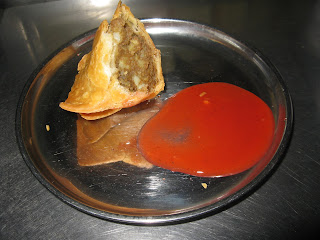One of the things I looked forward to most about India was eating the food. There were a few let downs, but mostly gems in Mumbai. Mumbai is the capital of the Maharstra state which is a large stretch of barren land. Apparently, the people have a simple diet subsisting of grains and pulses. Not very exciting. However, India is a large country and each region has its own unique variations of popular dishes. Since people from all over India live in Mumbai you can get any kind of Indian cuisine you want. Quite exciting!
We took advantage of that fact and tried some Parsi cuisine. The Parsis are a group of people who practice Zoroastrianism, a religion started in Persia during the sixth century. Eventully the Parsis were forced to leave and some migrated to India. Parsi cuisine is a mix of Northwest Indian food. We ate at Ideal Corner, a restaurant recommended in the Lonely Planet guidebook. I loved the quirky and colourful interior: a beautiful creamsicle orange with bold royal blue trim. It was full of business men and shoppers grabbing a quick bite.
Andrew and I tried two Parsi dishes: mutton curry and atheli aloo chicken masala. The masala was heavy on the garlic, onion, and spices in a good way. It was full of tangy flavour with a hint of heat. Andrew's mutton curry was tasty but the meat was a bit tough.
The real star in the city by the sea was the street food! Street food is always good because it's cheap, just what the budget traveler wants and needs, and it's delicious. I know a lot of people who hesitate to eat street food because they think they'll get sick. I've eaten a lot of street food and haven't been sick. So, I don't mind taking the risk, especially with the delicious eats you can find on the streets of Mumbai. The samosas at the stand we found by chance after seeing the sights and sounds of Crawford street market were incredible. They were in a tender and flaky pastry package that had a potato filling full of the flavours of India: coriander, turmeric, cumin and curry. We washed down our samosas with hot chai teas. Delicious!
The photo above is the most unique and complex street food I've had: bhlel puri. Bhlel puri is its name in Mumbai; masala puri outside Mumbai. It's kind of like a nacho. It has a crispy base and layers of ingredients are stacked on top of it. But that's where the similarities end. First, the vendor took a crispy papdi, a savoury chip made from flour, next he put a spoonful of stewed chickpeas, than a coriander chutney followed by a sweet chutney, than a mixture of chopped red onions and tomatoes and, finally, a shower of sev, rice vermicelli noodles. This is quite the mouthful of flavours and textures! As you can imagine all the ingredients mingle together and create a sublime combination of tastes that dip from savoury to sweet to sour and back again. All on a twoonie sized chip!
Those are some of the foods we've enjoyed so far. I'll be posting again soon about my first impressions of Mumbai and Goa.
We took advantage of that fact and tried some Parsi cuisine. The Parsis are a group of people who practice Zoroastrianism, a religion started in Persia during the sixth century. Eventully the Parsis were forced to leave and some migrated to India. Parsi cuisine is a mix of Northwest Indian food. We ate at Ideal Corner, a restaurant recommended in the Lonely Planet guidebook. I loved the quirky and colourful interior: a beautiful creamsicle orange with bold royal blue trim. It was full of business men and shoppers grabbing a quick bite.
 |
| Atheli Aloo Chicken Masala |
 |
| Samosa with sweet chili sauce |
The real star in the city by the sea was the street food! Street food is always good because it's cheap, just what the budget traveler wants and needs, and it's delicious. I know a lot of people who hesitate to eat street food because they think they'll get sick. I've eaten a lot of street food and haven't been sick. So, I don't mind taking the risk, especially with the delicious eats you can find on the streets of Mumbai. The samosas at the stand we found by chance after seeing the sights and sounds of Crawford street market were incredible. They were in a tender and flaky pastry package that had a potato filling full of the flavours of India: coriander, turmeric, cumin and curry. We washed down our samosas with hot chai teas. Delicious!
The photo above is the most unique and complex street food I've had: bhlel puri. Bhlel puri is its name in Mumbai; masala puri outside Mumbai. It's kind of like a nacho. It has a crispy base and layers of ingredients are stacked on top of it. But that's where the similarities end. First, the vendor took a crispy papdi, a savoury chip made from flour, next he put a spoonful of stewed chickpeas, than a coriander chutney followed by a sweet chutney, than a mixture of chopped red onions and tomatoes and, finally, a shower of sev, rice vermicelli noodles. This is quite the mouthful of flavours and textures! As you can imagine all the ingredients mingle together and create a sublime combination of tastes that dip from savoury to sweet to sour and back again. All on a twoonie sized chip!
Those are some of the foods we've enjoyed so far. I'll be posting again soon about my first impressions of Mumbai and Goa.




